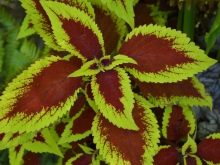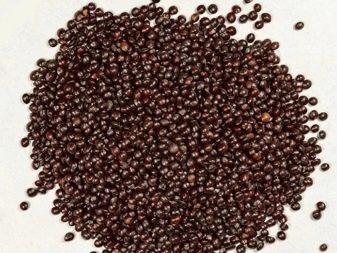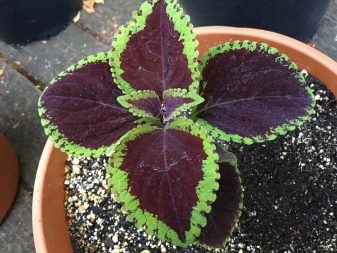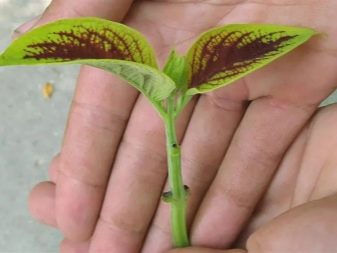Coleus: types, features of planting and care

People who grow flowers at home know about the decorative coleus. It is easily grown not only indoors, but also in offices. This flower is called "poor man's croton", as it has some external resemblance to croton, but it is more bright.



Description
Coleus is a plant species that belongs to the genus of multicolored evergreen flora, as well as labiates. It is popularly called nettle. Asia and Africa are considered the birthplace of an attractive flower. The height of this decorative deciduous shrub often reaches 35 centimeters.
Coleus has a quadrangular translucent juicy stem. The foliage of the plant is characterized by velvety, it can be painted in various colors and has serrated margins. In many species of coleus, the leaves are very similar to those of nettles. It is the leaves that are considered the main decoration of the shrub; they can be a combination of red, yellow, green, brown stripes and spots. This flower looks very attractive and colorful.
The flowering of a dwarf shrub occurs by throwing up a panicle, while its flowers are unremarkable. On open ground, large-leaved varieties are most often grown, which are characterized by rapid growth and turn into fluffy dwarf shrubs. Potted indoor species can decorate and complement any room.



Types and varieties
A florist who decided to acquire a Coleus will have to make a choice from a large number of varietal and species diversity of this plant. Each of the representatives is characterized by a unique color and shape of the leaves. The color of the leaf can be pink to black, and their edges are denticulate, fringed or curly. Let's list the most popular varieties of Coleus.
- Hybrid. The plant can reach a height of 30 to 80 cm. The foliage of the dwarf shrub can be either monochromatic or multi-colored.


- Blume. A characteristic feature of the flowers of this species is the ovoid shape of the leaves and the sharpness of their edges. The leaves are very similar to nettle, their color is variegated and contains several shades. Often, the core of the leaf is crimson, and the margin is green, it can also be wavy. An interesting variant of Coleus bloom can be called Vechernyaya Zarya, Kong Scarlet.


- Wizard - This is a decorative indoor flower, the cultivation of which will not be difficult even for an inexperienced grower. Nettle height reaches 0.3 meters. The foliage of the representative is miniature and has a rounded shape. The colors can be very diverse, while the decorativeness of the shrub is given by a bright green edging


- "Black dragon" stands out among other representatives of the Coleus with its dark foliage. The color of the leaves can be from burgundy to brownish-purple. This miniature dwarf shrub has a fairly dense crown.


- Fireway Rose Is a perennial that can be grown as an annual flower. The plant is characterized by compactness, its height does not exceed 0.35 meters, and its diameter is 0.3 meters. The foliage of the shrub is equipped with a crimson core, burgundy stains and a green edging.
This houseplant prefers a sunny or slightly shaded place, as well as rich, light soil.


Landing
If you plan to plant a Coleus in the open field, then the place should be chosen carefully. This plant prefers well-lit areas, due to which the shrub is covered with variegated and healthy foliage. When choosing a place to plant nettles, it is worth attaching importance to some nuances.
- White and red nettles can be planted directly in direct sunlight.
- The variety, which is characterized by green foliage, does not like the brightness of light so much, therefore, during the active phase of the sun, the grower will have to shade the plant. The best option would be to plant a representative of the flora in a shaded place, otherwise it may suffer from burns.
The second important point when planting Coleus is the correct selection of soil. This type of plant can be planted on any soil, but nitrogen and nutrients must be present in it.

The correct substrate contributes to normal growth, foliage beauty and the expressiveness of the pattern on it. The best soil composition for Coleus is as follows:
- black soil - 4 servings;
- pine needles - 2 servings;
- cow dung - 2 servings;
- sand - 1 portion.
For proper preparation of the soil, it must be heated and sieved. Coleus can be planted by seeds or as seedlings. When using seeds, the grower will have to wait longer for seedlings to appear. By planting seedlings, you can quickly get a beautiful decorative dwarf shrub. Sowing of seeds is carried out in the second half of March, after 7 days, shoots begin to appear.


From the moment the sprouts appear, the coating can be removed, and the container should be sent to a well-lit area, the best option for this would be a window in the east or west. The temperature should be maintained at +17.19 degrees Celsius, while it is worth protecting the nettles from the direct influence of the sun's rays. Planting coleus with seeds is an effective method that will allow the grower to become the owner of a chic ornamental plant.
Seedlings should be planted in open ground after thoroughly warming up. If young coleuses were grown on a windowsill, they are transplanted into open ground without effort. When buying seedlings, it is worth considering the color of the foliage and stem, as well as the elasticity of the stem. Planting in open ground should be carried out in the first half of June in warm soil.
The flower grower will have to make holes of the required size, and then fill them with a nutritious substrate. Planting seedlings should be carried out subject to the distance between plants.


Care rules
In order to grow Coleus at home in an apartment or in a garden in the country, it should be properly looked after. A flower in a flowerbed and in a pot needs moderate irrigation, fertilization and pruning at home, in some situations it should be kept in the shade.
In the warm season when growing nettles moderation of watering is required... For this procedure, it is necessary to use water that has settled. During hot weather, the shrub will need additional spraying, which will not allow the upper soil layer to dry out. In winter, the amount of irrigation decreases, but it is not worth overdrying the land. With a lack of moisture, the plant wilts, as well as the loss of its elasticity.

Perennials and annuals need proper feeding.
- The first fertilization occurs 2 weeks after the dive of the seedlings. Top dressing of young seedlings should be less saturated than indicated on the package, an ideal option would be to reduce the concentration by 3-4 times.
- In the phase of active growth of nettle, it is necessary to fertilize it every 7 days. For this purpose, it is worth purchasing a complex fertilizer that is intended for this decorative representative.Potash fertilizer is considered a good option.
- In the winter season, feeding the Coleus should be done once a month., while it is worth diluting the dose of the substance by 2 times.


A florist should know that do not allow spontaneous growth of shoots... The first pinching is carried out at a time when the plant grows to 10-12 centimeters. After that, it is worth shortening the shoots from the sides, and forming a half-shrub at your discretion. The twigs that are cut can be used to propagate the Coleus. If the nettle blooms at the wrong time, then it throws out an arrow that has no decorative features. It is better to cut the flower arrow, so the plant will save its energy.
In spring and summer, Coleus, which grows indoors, requires similar care measures as for a garden representative. A florist must not forget on the regularity of watering, as well as the introduction of fertilizers with a high nitrogen content, the formation of room nettles. Humidification should be carried out with settled water at room temperature, sometimes using a spray bottle. The flower should be taken out to the balcony, as it has a positive attitude towards fresh air.
In the cold season, the Coleus growing in a pot should be fertilized once a month and watered several times less than in the warm season.

Reproduction methods
Each owner of a decorative coleus should know about the methods of its reproduction. There are two of them: cuttings and seeds. The half-shrub propagates by cuttings is quite simple; for this procedure, you can even use the shoot that remained after pruning. The planting material must be at least 10 centimeters high. It is worth removing the foliage from the lower part of the cutting and deepening the coleus into wet soil.
To create a greenhouse effect, young flowers should be covered with plastic wrap or a plastic cup. For successful rooting, the pot must be shaded at a temperature of 20 degrees Celsius.
After 14 days, rooted coleus can be planted in a permanent place of growth. Some growers place the cuttings of the plant in cups of water, which contains a drug that stimulates the formation of the root system. Containers with cuttings are sent to the windowsill and wait for the roots to appear. After the formation of the root system, young nettles are planted in the soil.


For sowing Coleus seeds, it is worth preparing containers with a shallow depth. A fertile light substrate and seeds are poured into the container. The location of the latter should be carried out on the soil surface, after which the seeds must be sprinkled with sand a little without covering. The last stages of sowing will be to moisten the nettles with a spray bottle and cover the container with a transparent cloth. Germination of seeds is carried out on a warm and light windowsill.
The temperature, which contributes to the rapid and high-quality germination of planting material, ranges from 20 to 25 degrees Celsius. Aeration and removal of liquid droplets from the covering material have a positive effect on the condition of the germinating coleus. The first shoots appear 2 weeks after sowing. At this time, it is worth removing the cover from the container.
For rapid further cultivation to occur, the boxes with vegetation should be defined on the western or eastern windowsill.


Flowering features
The flowering of coleus cannot be called a decorative process, therefore, at this time, many growers do not pay much attention to the semi-shrub. In this phase, blue-violet flowers appear at the nettle, which are collected in complex inflorescences. At this time, the flower spends a large amount of vitality, so the best option after the formation of the inflorescence is to remove it... In some varieties, the flowers exude a pleasant aroma, but the shrubs look inconspicuous at this time.


Diseases and pests
The decorative appearance of the Coleus is influenced by the correctness and regularity of taking care of it. The depressed appearance of a plant is a consequence of various circumstances.
- High soil weight. Poor drainage causes water stagnation near the roots of the shrub. This situation causes decay of the roots, and the flower, in turn, becomes weak and loses its leaves.
- Excess watering. Despite the fact that Coleus has a positive attitude towards abundant watering, it does not tolerate waterlogging. The soil should be kept moist, avoiding swampiness.
- Not enough water. Uneven watering and insufficient watering can cause the soil coma to dry out, which causes loss of leaves and death of the coleus.
- Lack of light. Since the nettle is a light-loving plant, improper illumination will lead to a loss of decorative qualities. Poor lighting leads to elongation of the shoots and the absence of a bright color of the leaves.
- Direct sunlight. Burns on the leaves can occur on a hot sunny day. As a consequence of this situation, the leaves dry and shatter.


In a weakened state, pests such as whiteflies, aphids, ticks, mealybugs often attack the Coleus. If aphids are found on a houseplant, it is worth treating it with a soap-based solution. This procedure is repeated after 7 days. Florists should remember that before treating the nettle with soapy water, cover the soil with material that does not get wet. In the garden, aphids are fought with the help of insecticides, good results are given by "Aktara", "Fitoverm", "Aktellik".
Whitefly is eliminated by the above methods. To combat ticks, use "Akarin", "Apollo", "Oberon".


Use in landscape design
Currently, the use of coleus in a flower arrangement by landscape designers is not uncommon. A beautiful combination can be obtained by combining plants with a solid color. The most harmonious can be called the compositions of Coleus with the participation of sage, cineraria, lily, daylily, gypsophila. The classic option is the combination of purple nettle with yellow marigolds, red salvia, cineraria with a silvery tint.
Red nettle with silver alissum looks perfect. From several types of coleus, you can create an attractive carpet bed or arabesque. The "Persian carpet" is capable of beautifully decorating the lawn, which includes different varieties of dwarf shrubs. To decorate a small courtyard, you can use a container that contains a composition of colorful coleus, cannes with red leaves in addition to green or yellow flowers.
The dwarf coleus, which is combined with a curb sheared boxwood, is an excellent decoration for rose gardens. Red and burgundy roses can be successfully combined with pale green or golden coleus. Often, ampelous nettles are used to decorate loggias. The balcony, which is decorated with such original bright vegetation, looks unique and attractive.



For information on how to care for Coleus, see the next video.



































































































I love coleuses, hosts, heucheras, junipers and beautiful small flowering shrubs in my garden!
The comment was sent successfully.